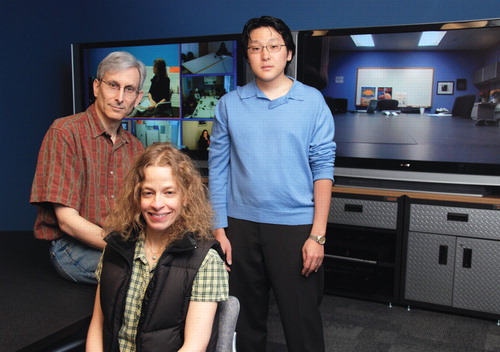Psychiatrists, Patients Praise Benefits of Telehealth
University of New Mexico psychiatrists use computer-based video teleconferencing systems to overcome the barriers of distance and provider scarcity in a state where patients might otherwise need to drive hours to see a doctor, explained child and adolescent psychiatrist Avi kreichman, M.D., an assistant professor and the telehealth specialist at the Center for Rural and Community Behavioral Health in Albuquerque (see Original article: Rural Psychiatry Isn't Easy, but Rewards are Ample).
An Internet-based system carries one-on-one or group conferences with up to 40 remote sites, although psychiatry usually uses only 10, explained technology manager Wesley Pak, M.B.A., recently. Sessions can be recorded and encrypted to meet Health Insurance Portability and Accountability Act standards. The big projection screen at the front of the room is divided into as many small screens as there are participants. When someone speaks, a voice-actuated system enlarges that person's screen area.
“Patients like it because it saves them money and hours of travel time,” said Pak.

There have been two traditional ways to use telehealth, said Kreichman, sitting in the large studio a few blocks from the university's Health Sciences Center. Specialists either offered consulting services to a primary care provider, or they assessed and treated patients who came to the remote site, sometimes with a local clinician.
“We follow those models, but we also help train primary care providers in rural areas, as well as teachers, school psychologists, nurses, parents, children, and health assistants at schools,” he said. He has even trained school security guards, bus drivers, and cafeteria workers in aspects of drug addiction or other topics.
These may be didactic programs or case conferences followed up with phone calls or e-mails.
One morning in March, Kreichman opened a teleconference with counselors at a rural high school concerned about a rash of teenage pregnancies. The discussion ranged from parent-child relationships to the pregnant girls' emotional states. Kreichman reinforced efforts by the adults to support the teenagers and get them prenatal care and appropriate counseling.
Later one participant expressed her frustration at the way teen pregnancy was considered only as an individual matter by local school authorities, rather than one involving broader social and cultural attitudes. Kreichman's knowledge of health systems led him to offer her specific suggestions for approaching state education officials to find some solutions.
Another faculty member, assistant professor Florian Birkmayer, M.D., an addiction specialist, spends one day a week on camera, half for the Indian Health Service and half for a clinic in Carlsbad, N.M.
The emotional connection can be as intense using telehealth as it is in person, said Birkmayer, although he's noticed one interesting phenomenon about telepsychiatry. “At Carlsbad, when I start with a new patient in person, [the patient is] often reluctant to move to telehealth services, but if we begin with telehealth, it goes much more easily,” he said. ▪ Original article:



